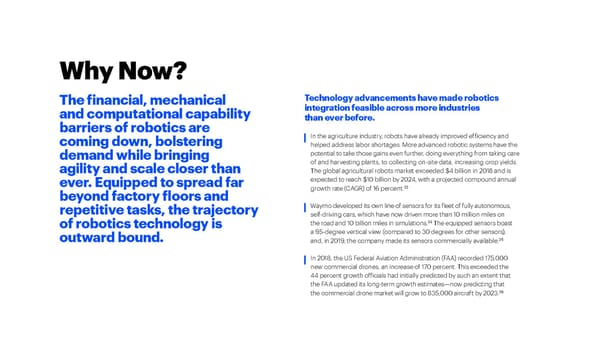Why Now? The financial, mechanical Technology advancements have made robotics and computational capability integration feasible across more industries barriers of robotics are than ever before. coming down, bolstering In the agriculture industry, robots have already improved efficiency and helped address labor shortages. More advanced robotic systems have the demand while bringing potential to take those gains even further, doing everything from taking care of and harvesting plants, to collecting on-site data, increasing crop yields. agility and scale closer than The global agricultural robots market exceeded $4 billion in 2018 and is ever. Equipped to spread far expected to reach $10 billion by 2024, with a projected compound annual beyond factory floors and growth rate (CAGR) of 16 percent.33 repetitive tasks, the trajectory Waymo developed its own line of sensors for its fleet of fully autonomous, self-driving cars, which have now driven more than 10 million miles on 34 of robotics technology is the road and 10 billion miles in simulations. The equipped sensors boast a 95-degree vertical view (compared to 30 degrees for other sensors), outward bound. and, in 2019, the company made its sensors commercially available.35 In 2018, the US Federal Aviation Administration (FAA) recorded 175,000 new commercial drones, an increase of 170 percent. This exceeded the 44 percent growth officials had initially predicted by such an extent that the FAA updated its long-term growth estimates—now predicting that the commercial drone market will grow to 835,000 aircraft by 2023.36
 Tech Vision 2020 Interactive Report Page 97 Page 99
Tech Vision 2020 Interactive Report Page 97 Page 99